You can Download Samacheer Kalvi 9th Social Science Book Solutions Guide Pdf, Tamilnadu State Board help you to revise the complete Syllabus and score more marks in your examinations.
Tamilnadu Samacheer Kalvi 9th Social Science Geography Solutions Chapter 1 Lithosphere – I Endogenetic Processes Questions and Answers
Lithosphere – I Endogenetic Processes Textual Exercise
I. Choose the correct answer.
Lithosphere 1 Endogenic Processes Question 1.
The ………….. is the rigid outer layer of the Earth.
(a) core
(b) mantle
(c) Crust
(d) inner core
Answer:
(c) Crust
Lithosphere Endogenic Process Question 2.
…………… layer is made up of liquid iron.
(a) Inner core
(b) Outer core
(c) Mantle
(d) Crust
Answer:
(b) Outer core
9th Social Guide Question 3.
Magma is found in the ……………
(a) crust
(b) mantle
(c) core
(d) None of the above
Answer:
(b) mantle
Lithosphere 1 Endogenic Processes Answers Question 4.
Diastrophism is connected to ……………
(a) volcanism
(b) earthquakes
(c) tectonics
(d) fold/fault
Answer:
(c) tectonics
Endogenetic Processes Match Question 5.
The movement of tectonic plates is induced by ………….. energy.
(a) hydel
(b) thermal
(c) wave
(d) tidal
Answer:
(b) thermal
Samacheer Kalvi 9th Social Book Answers Question 6.
In the ancient period, Gondwana land moved towards ………….. direction.
(a) north
(b) south
(c) east
(d) west
Answer:
(a) north
Social 9th Guide Question 7.
Many million years ago, India was a part of the super continent ………….
(a) Gondwana
(b) Laurasia
(c) Panthalasa
(d) Pangea
Answer:
(a) Gondwana
9th Social Guide 2020 Question 8.
The movement of plates that creates stress and tension in the rocks causing them to stretch and cracks result in ………….
(a) fold
(b) fault
(c) mountain
(d) earthquake
Answer:
(b) fault
Samacheer Kalvi Guru 9th Social Science Question 9.
……………… refers to a bowl-shaped depression found at the top of the volcano.
(a) crater
(b) vent
(c) chamber
(d) volcanic cone
Answer:
(a) crater
9th Social Science Guide Question 10.
The point of origin of an Earthquake is called the …………..
(a) epicentre
(b) focus
(c) seismic wave
(d) magnitude
Answer:
(a) epicentre
II. Match the following.

Answer:

III. Consider the given statements.
9th Social Guide New Syllabus Question 1.
(i) Mt. Fuji is a dormant Volcano.
(ii) Mt. Kilimanjaro is a dormant Volcano.
(iii) Mt. Tanzania is a dormant Volcano.
Which of the statement(s) is are true?
(a) (i) is true
(b) (ii) is true .
(c) (iii) is true
(d) (i) (ii) (iii) are true
Answer:
(a) (i) is true
9th Standard Social Guide Question 2.
Statement: Magma gushes out when it finds vents.
Reason: Interior of the Earth contains compressed hot magma.
Which of the statement(s) is are true?
(a) Statement & reason are true
(b) Statement is true, reason is false
(c) Statement is false reason is true
(d) Statement & reason are false
Answer:
(a) is true
9th Standard Social Science Guide Question 3.
Statement I: Mountain ranges are formed by the collision of tectonic plates.
Statement II: The movement of tectonic plates is due to the thermal energy from the mantle.
(a) Statement I is false II is true
(b) Statement I and II are false
(c) Statement I is true II is false
(d) Statement I and II are true
Answer:
(d) is true
IV. Answer the following in one or two sentences.
Chapter 1 Lithosphere – I Endogenetic Processes Question 1.
Write a brief note on the various spheres of the Earth.
Answer:
(i) The Earth is divided into Biotic and ABiotic Spheres.

(ii) Biotic sphere is the Biosphere
A Biotic sphere is further divided into Lithosphere, Atmosphere and Hydrosphere.
9th Std Social Science Guide Pdf Question 2.
Mention the layers of the interior of the Earth.
Answer:
The structure of the Earth’s interior is divided into three layers namely the crust, the mantle and the core.
9th Std Social Science Guide Pdf English Medium Question 3.
What is pedosphere?
Answer:
The ‘Pedosphere’ is part of the lithosphere made up of soil and dirt. It exists at the interface of lithosphere, atmosphere, hydrosphere and biosphere.
Samacheer Kalvi 9th Social Science Book Answers Question 4.
Define Plate tectonics.
Answer:
- The tectonic plates float independently.
- Collisions of the tectonic plates produce mountain ranges and other irregular surface features both on land and the ocean floor. This phenomenon is called ‘Plate tectonics.’
9th Social Science Book Back Answers Question 5.
Write a note on Fold and fault?
Answer:
Folding: Due to lateral compressional forces, the plates are forced to move upwards and downwards. This is called‘Folding’.
Faulting: The movement of plates also create stress and tension in the rocks, causing them to stretch and crack. This called ‘faulting’.
Samacheer Kalvi 9th Books Social Science Question 6.
What is Tsunami?
Answer:
- The word Tsunami is a Japanese term meaning harbour waves.
- It is adopted to describe large seismically generated sea waves caused by Earthquakes Submarine explosions and landslides.
9th Social Guide Pdf Question 7.
What is a Volcano? Mention its major components.
Answer:
A volcano is a vent or an opening on the surface of the Earth’s crust through which hot solid, liquid and gaseous materials (Magma) erupt out to the surface from the Earth’s interior.
Samacheer Kalvi Social Science 9th Std Question 8.
What is an Earthquake and how it occurs?
Answer:
Earthquakes are generally caused by the sudden vibrations in the Earth’s crust which spreads outward in all directions as waves from the source of disturbance.
Social Guide For Class 9 Samacheer Kalvi Question 9.
What are seismic waves and mention its types?
Answer:
Earthquakes generate seismic waves. The nature force and speed of these seismic waves depend on the nature of the medium through which it passes.
The major types are
(a) Primary (or) P waves
(b) Secondary (or) S waves
(c) Surface waves (or) L waves.
Samacheer Kalvi 9th Social Science Book Solutions Question 10.
Write about the Pacific Ring of fire.
Answer:
- The Pacific Ring of fire is an arc around the Pacific Ocean where many volcanoes are found.
- The Pacific Ring of fire is the most seismically and volcanically active zone in the world.
V. Give Reasons for the following.
Samacheer Kalvi 9th Standard Social Question 1.
SIAL floats over SIMA.
Answer:
- SIAL consists of Silica and Aluminium.
- SIMA contains Silica and Magnesium.
- SIAL is lighter than SIMA.
Therefore SIAL floats over SIMA.
9th Standard Social Science Guide Pdf Question 2.
Igneous rocks are also called Primary Rocks or Mother rocks.
Answer:
Igneous rocks are also called Primary Rocks (or) Mother rocks because all other rocks are directly or indirectly formed from them.
VI. Distinguish between.
Question 1.
Core and crust.
Answer:
| S.No. | Core | Crust |
| (i) | The core is the innermost hottest layer of the earth and the true centre. | The crust is the outer layer of the earth. |
| (ii) | It is composed mainly of Nickel (Ni) and Iron (Fe). So it is termed as NIFE. | It is composed of Silica and Aluminium. So it is termed as SIAL. |
| (iii) | Denser materials exist within Earth’s core. | Lighter materials exist on the surface. |
Samacheer Kalvi Guru Social 9th Question 2.
Epicentre and Hypocentre.
Answer:
| S.No. | Epicentre | Hypocentre |
| (i) | Epicentre is a point on the Earth’s surface that lies directly above the focus. | It is a point within the earth where an earthquake rupture starts. |
| (ii) | The impact of the Earthquake is felt, the most at the centre. | It generates series of elastic waves. |
9th Standard Samacheer Kalvi Social Question 3.
Divergent and convergent boundaries.
Answer:
| Divergent Boundary | Convergent Boundary |
| The plates pull away from each other as magma pushes up from the mantle. | The plate moves towards each other and sometimes a plate sinks under another. |
9th Social Guide 2020 Pdf Question 4.
Primary waves and Secondary waves.
Answer:
| S.No. | Primary waves | Secondary waves |
| (i) | These waves are the fastest of all the Earthquake waves and the first to reach the epicentre. | Secondary waves travel less faster than the primary waves. |
| (ii) | These waves pass through solids, liquids and gases. | These waves travel only through solids. |
| (iii) | The average velocity of these waves is -5.3 k.m/sec to 10.6 k.m/second. | The average velocity of these waves is 1 k.m/sec to 8 k.m/second. |
9th Social Book Back Answers Question 5.
Shield Volcano and Volcanic Dome.
Answer:
| S.No. | Shield Volcano | Volcanic Dome |
| (i) | Shield volcanoes are formed by intense viscous lava. | A lava dome (or) Volcanic dome is roughly circular mound formed due to the slow ejection of viscous lava from a volcano. |
| (ii) | As the lava is rich in silica with intense viscosity, it is prevented from flowing far from its vent, e.g., Paricutin, Mexico. | These are shallow depositions with gently sloping sides. Hence the lava flows out in all directions to create a shield, e.g., Mauna Loa, Hawai. |
VII. Write answers in a Paragraph.
9th Std Social Guide Question 1.
Describe the structure of the Earth.
Answer:
The outer surface and inner core of the Earth are totally different in their nature and structure. The structure of the Earth’s interior is divided into three layers namely the crust, the mantle and the core.
Crust: Crust is the outer layer of the Earth, where we live. It is the skin of our Earth, which ranges between 5 to 30 km. It is the solid and rigid layer of the Earth. The thickness of the crust is greater below the continents than the ocean floor. The crust is classified as continental crust and oceanic crust. The major elements of crust are Silica (Si) and Aluminium (Al) and thus, it is termed as SIAL.
Mantle: The interior part beneath the crust is called mantle, which is about 2,900 km thick. The major elements of the mantle are Silica (Si) and Magnesium (Mg) and hence it is also termed as SIMA. In the upper part of the mantle, the rock remains solid, whereas in the lower part of the mantle, rocks are in molten form. This molten rock inside the Earth is called ‘magma’.
Core: The core is the innermost and hottest layer of the Earth which lies below the mantle.
It is composed mainly of Nickel (Ni) and Iron (Fe). Hence it is called NIFE. The core is divided into Solid inner core and Liquid outer core. The presence of large quantities of iron in the core is responsible for the Earth’s gravitational force. As the Earth rotates on its axis, the liquid outer core spins over the solid inner core and generates the Earth’s magnetic field.
This is responsible for the functioning of the magnetic compass. Due to high pressure, the materials in the inner core are unable to move and hence remain solid.
Social Science 9th Guide Question 2.
Write a note on the internal and external processes of Earth.
Answer:
The formation and deformation of landforms on the surface of the Earth is a continuous activity of two broad processes i.e. internal and external. These processes cause stress and deformation on Earth materials and finally bring changes on the surface of the Earth. These are referred as Geomorphic Processes.
The forces that act from the Earth’s interior towards the Earth’s surface are called Internal processes or Endogenetic processes. These forces build the landscape and create topographic relief.
The forces that act on the surface of the Earth due to natural agents like running water, glacier, wind, waves etc. are called External processes or Exogenetic processes. These external processes tear the landscape down into relatively low elevated plains.
Samacheer Kalvi 9th Social Guide Question 3.
How are volcanoes classified based on the periodicity of their eruptions?
Answer:
Based on the periodicity of eruptions, volcanoes are classified into
(i) Active volcano,
(ii) Dormant volcano
(iii) Extinct volcano.
(i) Active Volcano: Active volcanoes are those which constantly eject volcanic lava, gases and fragmented materials. (e.g.) Mount St. Helens in the United States.
(ii) Dormant Volcano: Volcanoes that do not show any sign of volcanic activity for a long period of time are known as dormant volcanoes. Sometimes there may be a sudden explosion. which may cause unimaginable loss to life and property (e.g. ) Mt. Fuji, Japan.
(iii) Extinct or Dead Volcano: When a volcano permanently stops its volcanic activity, then it is called as extinct or dead volcano (e.g.) Mt. Kilimanjaro, Tanzania.
Volcanoes can also be classified based on their structure and composition as composite volcano, shield volcano and dome volcano.
9th Standard Social Science Question 4.
Explain the effects of Volcanoes.
Answer:
Constructive Effects: Volcanic materials enrich the soil fertility that promotes agricultural activities. The hot volcanic region helps in generating geothermal energy. Many dormant and active volcanoes are the most attractive tourist spots of the world. Most of the volcanic materials are used as building materials.
Destructive Effects: Volcanic eruption causes Earthquakes, fast floods, mud slide and rock fall. Lava can travel very far and bum, bury, or damage anything in its path. The large amount of dust and ash makes breathing hard and irritable. Volcanic emptions can alter the weather conditions and disrupt transport (Iceland volcanic eruption) in and around the volcanic region.
VIII. Map Skill.
On the given outline map of the world, mark the following:
(a) Pacific Ring of fire
(b) Earthquake-prone zones (any two)
(c) Locate any two active volcanoes of the world
(d) Himalayas and Alps ranges
(e) Rift valley of East Africa
Answer:
(a) Pacific Ring of fire: It is a major area and an arc in the basin of the Pacific ocean where many earthquakes and volcanic emptions occur.
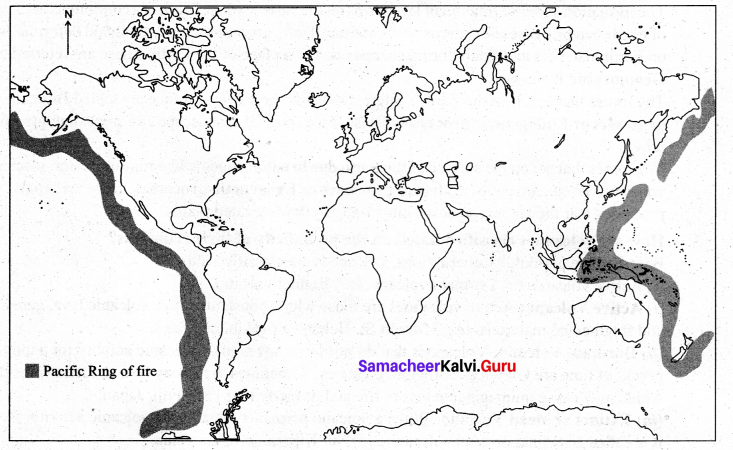
(b) Earthquake prone zones (any two): Turkey, Indonesia
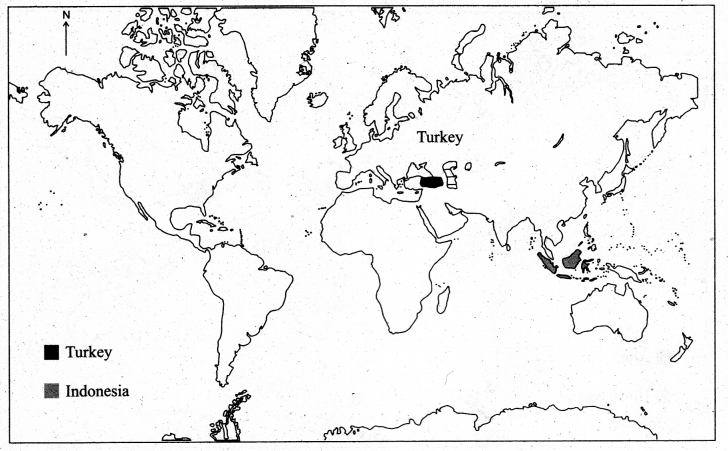
(c) Locate any two active volcanoes of the world: Hawaii, Mount Fujji
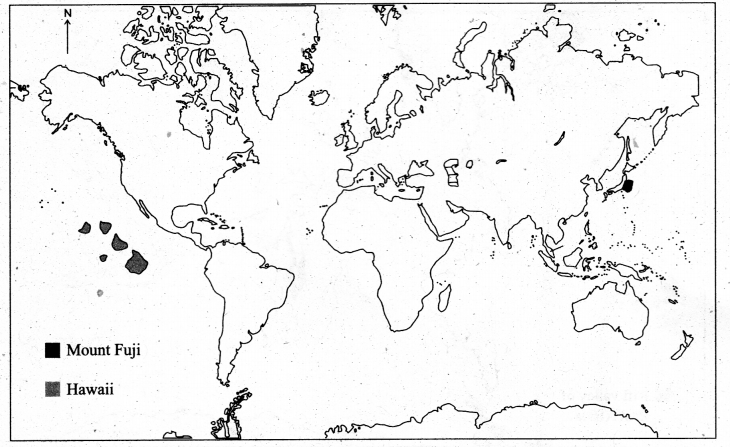
(d) Himalayas and Alps ranges
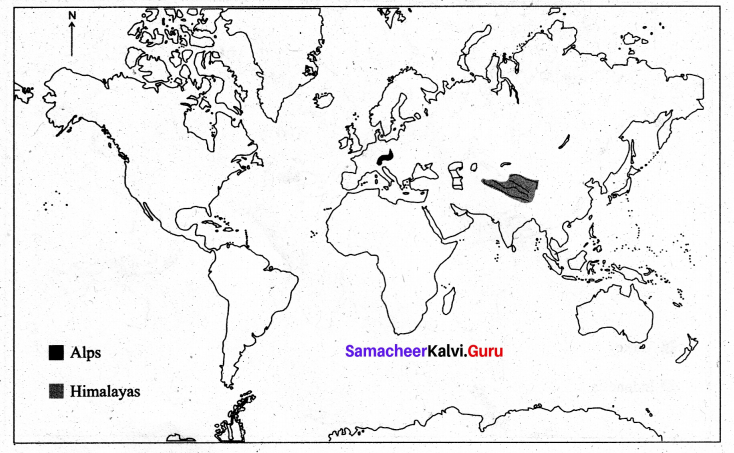
(e) Rift valley of East Africa
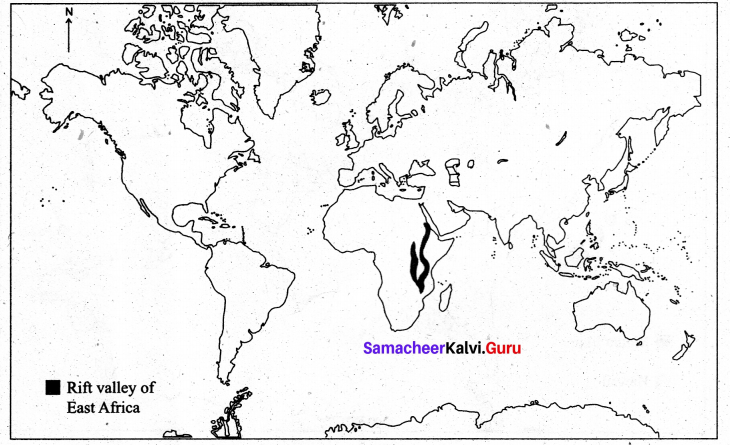
IX. Higher Order Thinking Skills (HOTs) Questions.
Question 1.
Consider the various sources of information related to the Earth’s Interior. Classify the above as DIRECT & INDIRECT sources of information. Give reasons.
Answer:
• Seismic activity
• Earth’s magnetism
• Volcanoes
• Mined rocks
• Gravitational force
• Meteors
- Seismic Activity: Frequency and size of earthquake.
- Earth’s magnetism: Due to the movement of molten material under the earth’s crust.
- Volcanoes: A rupture in the crust of a planetary mass object such as Earth, that allows hot lava, volcanic ash & gases to escape.
- Mined Rocks: Excavating hard minerals:
- Gravitational force: A natural phenomenon.
- Meteors: A bright streak of light.
Question 2.
Scientists use GPS to measure the rate of Tectonic Plate movements. Discuss.
Answer:
GPS works by sending radio signals from satellites to ground stations. The distance between the satellites and station is recorded. Over time, these distances change slightly. Scientists can measure the rate of Tectonic Plate movements by recording the time it takes for ground stations to move a given distance.
In-text HOTs Question
Question 1.
Pacific Ring of Fire — Most seismically and volcanically active. Why?
Answer:
The Pacific Ring of fire is an arc around the Pacific Ocean. It is associated with a nearly continuous series of oceanic trenches, volcanic arcs, and volcanic belts and plate movements. It has 452 volcanoes (more than 75% of the world’s active and dormant volcanoes). The Ring of Fire is a direct result of plate tectonics: the movement and collisions of lithospheric plates. That is why it is the most seismically and volcanically active zone in the world.
X. Life Skills
Imagine that you feel tremors or shocks in your locality. What will be your role in saving • lives from destruction? List out the Do’s and Don’ts.
Dos and don’ts during an earthquake
Do’s
- Be aware that some earthquakes are actually foreshocks and a larger earthquake might occur.
- If indoors, drop to the ground; cover your face and head with your arms and crouch in an inside comer of the building.
- Stay away from glass, windows, outside doors and walls, and anything that could fall, (such as lighting fixtures or furniture).
- Be aware that the electricity may go out or the sprinkler systems or fire alarms may turn on.
- If outdoors, avoid moving. However, move away from buildings, trees, streetlights, and utility wires.
- If you are in open space, stay there until the shaking stops.
- If in a moving vehicle, stop as quickly as safety permits and stay in the vehicle. Avoid stopping near or under buildings, trees, overpasses, and utility wires.
- If caught under debris, tap on a pipe or wall so rescuers can locate you. Shout if needed.
Don’ts
- Do not light a match.
- Do not move about or kick up dust.
- Cover your mouth with a handkerchief or clothing.
- Do not touch electrical switches.
- Do not operate electrical appliances.
Student Activities
Question 1.
Collect a few rock samples from your area and classify them on the basis of what you have learnt.
Answer:
You can do this activity under the guidance of your teacher.
Question 2.
Narrate the processes involved in the given rock cycle diagram in your own words.
Answer:
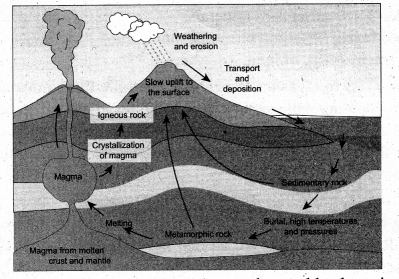
Rocks are continually changing from one type to another and back again. Rock Cycle is the geologic process that describes the transition of rocks between the three rock types: igneous, sedimentary, and metamorphic. The forces inside the earth bring the rocks closer to the surface. Here the rocks are weathered, eroded and compacted. Then the forces on the earth sink the rocks. Back down, the rocks are heated, pressed and melted. So the elements that create rocks are constantly being recycled.
Question 3.
Here is a list of a few mountains.
• Ural Mountains, Andes Mountains, Vindhya Range, Alps mountains
• Satpura range, Rocky Mountains, Sierra Nevada.
• Identify and Locate with help of atlas
Answer:
You can identify and locate the above mentioned mountains with the help of an atlas or Internet.
Question 4.
(a) Arrange a few books one above the other on a table. Just shake the table and observe what happens.
Answer:
You can do this activity under the guidance of your teacher.
(b) Ask two students to hold two ends of a rope. Instruct one of them to shake the rope, while the other holds it lightly and then firmly. What do you observe?
Answer:
You can do this activity under the guidance of your teacher.
Question 5.
Take a bottle filled with soda. Give it a few shakes. Now twist the cap open. What do you observe?
Answer:
A capped bottle is under a uniform pressure. The molecules of carbon dioxide gas and liquid are at an equilibrium (due to a uniform pressure). When we shake the bottle, the contents are pressurized. So when the cap is opened, the liquid comes out with a force and fizz.
Lithosphere – I Endogenetic Processes Additional Questions
I. Choose the correct answer.
Question 1.
This is the solid outer part of the Earth.
(a) Lithosphere
(b) Atmosphere
(c) Hydrosphere
(d) Biosphere
Answer:
(a) Lithosphere
Question 2.
The presence of large quantities of …………… in the core is responsible for the Earth’s Gravitational force.
(a) Aluminium
(b) Magnesium
(c) Iron
(d) Silica
Answer:
(c) Iron
Question 3.
This is the store house of rocks.
(a) crust
(b) core
(c) mantle
(d) None of the above
Answer:
(a) crust
Question 4.
The word ‘Igneous’ is derived from the …………… word.
(a) Arabic
(b) Roman
(c) Latin
(d) Sanskrit
Answer:
(c) Latin
Question 5.
The movement of tectonic plates is due to …………… energy from the mantle.
(a) Atomic energy
(b) Hydro energy
(c) Wind energy
(d) Thermal energy
Answer:
(d) Thermal energy
Question 6.
These waves are the fastest of all the Earthquake waves.
(a) P – waves
(b) S – waves
(c) L- waves
(d) None of the above
Answer:
(a) P – waves
Question 7.
The sixth deadliest natural disaster due to Tsunami caused in the year …………..
(a) 1996
(b) 1998
(c) 2000
(d) 2004
Answer:
(d) 2004
Question 8.
…………… is a vent (or) and opening on the surface of the Earth crust.
(a) Volcano
(b) Tsunami
(c) Earthquake
(d) None of the above
Answer:
(a) Volcano
Question 9.
This is a dead volcano.
(a) Mt. St. Helens
(b) Mt. Kilimanjaro
(c) Mt. Fuji
(d) Paricutin
Answer:
(b) Mt. Kilimanjaro
Question 10.
Composite volcanoes are commonly found in the ………….. ocean.
(a) Pacific
(b) Southern
(c) Indian
(d) Atlantic
Answer:
(a) Pacific
II. Match the following.
(a)

Answer:
1. (b)
2. (c)
3. (a)
4. (e)
5. (d)
b.

Answer:
1. (d)
2. (a)
3. (b)
4. (c)
III. Consider the given statements
Question 1.
(i) When magnia reaches this Earth’s surface, it is referred to as ‘Lava’. (True)
(ii) The interior of the earth contains very hot molten material called ‘Magma’. (True)
(iii) Sedimentary are also called Primary (or) Mother rocks. (False)
(a) (i) is true
(b) (i) & (ii) are true (iii) false
(c) (iii) is true
(d) (i), (ii), (iii) are true
Answer:
(b) (i) and (ii) are true (iii) false
Question 2.
(i) The plates move vertically in convergent Boundary. (False)
(ii) The plates pull away from each other in Transform boundary. (False)
(iii) The plates slide horizontally past each other in Transform Boundary. (True)
(a) (i) is false
(b) (i) and (ii) are false
(c) (ii) false (i) and (iii) are true
(d) (i) (ii) are false (iii) true
Answer:
(i) (ii) are false (iii) true
IV. Answer the following questions in one or two sentences.
Question 1.
What is Hydrosphere?
Answer:
The Hydrosphere is the watery part of the Earth’s surface including oceans, rivers, lakes and water vapour.
Question 2.
What are fossils?
Answer:
The bodies of plants and animals that fall on the sedimentary rock deposits get embedded in the layers and form fossils.
Question 3.
What do you know about the Active Volcano?
Answer:
Active volcanoes are those which constantly eject volcanic lava, gases and fragmented materials, e g., Mount St. Helens in the United states.
Question 4.
What is Geology?
Answer:
The science that deals with the physical structure and substances of the earth their history and the processes which act on them.
Question 5.
What do the internal processes generate?
Answer:
- The internal processes generate heat and eject materials from deep below the Earth’s crust.
- Internal radio activity in the principal source of power for this process.
V. Give reasons for the following.
Question 1.
Why did Tsunami occur on 26th December 2004?
Answer:
- It was the result of the Indo-Australian plate subducting below the Eurasian plate.
- It was caused by an Earthquake measuring a magnitude of above 9 in the Richter scale.
Hence the sea floor was uplifted, displacing the sea water above.
Question 2.
Why does the lava flow out in all directions in shield volcano?
Answer:
- Shield volcanoes are formed by intense viscous, lava.
- These are shallow depositions with gently sloping sides.
- Hence the lava flows out in all directions to create a shield.
VI. Distinguish between:
Question 1.
Internal Processes and External processes.
Answer:
| S.No. | Internal Processes | External processes |
| (i) | The forces that act from the Earth’s interior toward the Earth’s surface are called Internal processes. | The forces that act on the surface of the Earth due to natural agents like running water, glacier, wind, waves etc., are called External processes. |
| (ii) | These forces build the landscape and create topographic relief. | These external processes tear the landscape down into relatively low elevated plains. |
Question 2.
Seismology and Geology.
Answer:
| Seismology | Geology |
| The science that deals with Earthquakes is called‘Seismology’ | The science that deals with the physical structure and substance of the earth their history and the processes which act on them. |
Question 3.
Atmosphere and Biosphere.
Answer:
|
Atmosphere |
Biosphere |
| The atmosphere is a thin layer of gases that surround the Earth. | The Biosphere is the layer of Earth where life exists. |
VII. Write answers in a Paragraph.
Question 1.
Give an account of‘Tsunami’
Answer:
The word ‘Tsunami’ is a Japanese term, meaning harbour waves. It is adopted to describe large seismically generated sea waves caused by Earthquakes, submarine explosions and landslides. These waves travel at a great speed (more than 500 km per hour) and the length of the waves exceeds 600 km. These waves reach to a height of more than 15 m near the sea shore and are capable of causing destruction along the coastal area.
The 2004 Indian Ocean Earthquake that caused tsunami is the sixth-deadliest natural disaster which travelled at a speed of 600 km per hour with an estimated death toll of 2,80,000. The Earthquake which occurred near Indonesia at 00.58 hours took nearly 7 hours to reach Chennai.